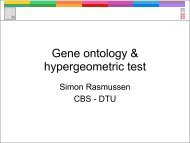Computational tools and Interoperability in Comparative ... - CBS
Computational tools and Interoperability in Comparative ... - CBS
Computational tools and Interoperability in Comparative ... - CBS
Create successful ePaper yourself
Turn your PDF publications into a flip-book with our unique Google optimized e-Paper software.
phylogenies based on alternative housekeep<strong>in</strong>g genes can<br />
differ from a 16S rRNA tree <strong>and</strong> frequently are not even <strong>in</strong><br />
accordance to each other. Such observations question the<br />
validity of a phylogenetic tree as the most suitable model<br />
for bacterial ancestry, when multiple genetic transfers<br />
would produce a network-like evolutionary structure [6].<br />
On the other h<strong>and</strong>, it is observed that lateral gene transfer is<br />
most frequent between genetically related members shar<strong>in</strong>g<br />
a similar base content <strong>and</strong> occupy<strong>in</strong>g the same ecological<br />
niche [29]. Nevertheless, a core of genes can be recognised<br />
that produce coherent phylogenetic trees, though these may<br />
not represent the species’ complete evolutionary history as<br />
they comprise only a m<strong>in</strong>or fraction of the genetic content<br />
of the organism [35].<br />
Whether a tree or a network is more accurate to describe<br />
phylogeny, <strong>in</strong> either case bacterial species may be considered<br />
as a cloud of isolates hav<strong>in</strong>g a higher level of genetic<br />
similarity to each other than to organisms belong<strong>in</strong>g to a<br />
different species. When such clouds have fuzzy <strong>and</strong><br />
overlapp<strong>in</strong>g borders, the species concept falls apart but that<br />
will only apply to certa<strong>in</strong> cases [7]. S<strong>in</strong>ce 16S rRNA genes<br />
are not <strong>in</strong>formative on the level of diversity with<strong>in</strong> a<br />
species, the 'density' of a cloud of isolates mak<strong>in</strong>g up a<br />
species cannot be determ<strong>in</strong>ed by this gene. Those genes<br />
shared by all isolates belong<strong>in</strong>g to one species comprise the<br />
core genome of that species [39], <strong>and</strong> the degree of<br />
diversity <strong>in</strong> the rema<strong>in</strong><strong>in</strong>g non-core genes determ<strong>in</strong>es the<br />
density of the species cloud.<br />
We hypothesised that certa<strong>in</strong> genes can be recognised as<br />
specific to a particular species, to be conserved <strong>in</strong> that<br />
species but not present <strong>in</strong> related species. We tested our<br />
hypothesis with complete genome sequences of the bacterial<br />
family Vibrionaceae, which belong to the γ-<br />
Proteobacteria <strong>and</strong> comprises eight genera. Most available<br />
genome sequences belong to the genus Vibrio. This genus<br />
conta<strong>in</strong>s 51 recognised species [10, 46] which are ma<strong>in</strong>ly<br />
found <strong>in</strong> mar<strong>in</strong>e environments, frequently liv<strong>in</strong>g <strong>in</strong> association<br />
with mar<strong>in</strong>e organisms such as corals, fish, squid or<br />
zooplankton. Most of them are symbionts <strong>and</strong> only a few<br />
are human pathogens, notably particular serotypes of V.<br />
cholerae produc<strong>in</strong>g cholera, Vibrio parahaemolyticus<br />
(caus<strong>in</strong>g gastroenteritis) <strong>and</strong> Vi vulnificus (caus<strong>in</strong>g wound<br />
<strong>in</strong>fections) [46]. Other Vibrionaceae, <strong>in</strong>clud<strong>in</strong>g V. vulnificus,<br />
Aliivibrio salmonicida <strong>and</strong> V. harveyi, are fish or<br />
shellfish pathogens <strong>and</strong> have major economic impact.<br />
Photobacterium profundum, represent<strong>in</strong>g another genus<br />
with<strong>in</strong> the Vibrionaceae, was also <strong>in</strong>cluded.<br />
The gene content of 32 available sequenced Vibrionaceae<br />
genomes was compared <strong>and</strong> the results were analysed <strong>in</strong><br />
various ways. The data allowed us to identify possible V.<br />
cholerae-specific genes, s<strong>in</strong>ce this species was represented<br />
by 18 genomes that was a sufficient number to test<br />
conservation both with<strong>in</strong> the species <strong>and</strong> across species.<br />
We found that a two-component signal transduction pathway<br />
is uniquely conserved <strong>in</strong> V. cholerae but is not found outside<br />
this species. Our f<strong>in</strong>d<strong>in</strong>gs further <strong>in</strong>dicated that possibly a<br />
relatively small set of genes could confer niche specialisation<br />
allow<strong>in</strong>g V. cholerae to be adopted to a unique environment,<br />
so that over time V. cholerae have become a dist<strong>in</strong>ct species.<br />
Materials <strong>and</strong> Methods<br />
Genomes <strong>and</strong> Gene Annotations Used<br />
Publicly available genome sequences of Vibrionaceae were<br />
selected that were provided <strong>in</strong> less than 300 contigs <strong>and</strong> <strong>in</strong><br />
which full-length 16S rRNA sequence could be found us<strong>in</strong>g<br />
the rRNA gene f<strong>in</strong>der RNAmmer [19]. The 32 genome<br />
sequences <strong>in</strong>cluded are shown <strong>in</strong> Table 1.<br />
The gene annotations as provided <strong>in</strong> GenBank were<br />
used, except for those genomes marked “Easygene” <strong>in</strong><br />
Table 1 where prote<strong>in</strong> annotation was not available <strong>in</strong> the<br />
RefSeq file at the time of analysis, <strong>and</strong> we used EasyGene<br />
[20] to identify the genes. As a control, an available<br />
GenBank annotation was compared to a generated Easygene<br />
annotation to confirm that the number of identified<br />
genes was comparable.<br />
Ribosomal RNA Analysis<br />
RNAmmer [19] was used to identify 16S rRNA sequences<br />
with<strong>in</strong> the 32 genomes. Sequences were considered reliable<br />
if they were between 1,400 <strong>and</strong> 1,700 nucleotides long <strong>and</strong><br />
had an RNAmmer score above 1,800. In cases where the<br />
program found multiple <strong>and</strong> variable 16S sequences with<strong>in</strong><br />
a genome, one of these (with satisfactory RNAmmer<br />
scores) was arbitrarily chosen. The sequences were aligned<br />
us<strong>in</strong>g PRANK [23, 24], <strong>and</strong> the program MEGA4 was used<br />
to elucidate a phylogenetic tree [45]. With<strong>in</strong> MEGA4, the<br />
tree was created us<strong>in</strong>g the Neighbor-Jo<strong>in</strong><strong>in</strong>g method with<br />
the uniform rate Jukes–Cantor distance measure <strong>and</strong> the<br />
complete-delete option. Five hundred resampl<strong>in</strong>gs were<br />
done to f<strong>in</strong>d the bootstrap values.<br />
Pan-Genome Family Cluster<strong>in</strong>g<br />
T. Vesth et al.<br />
Cluster<strong>in</strong>g based on shared gene families from the Vibrio<br />
pan-genome was constructed, based on BLASTP similarity<br />
us<strong>in</strong>g default sett<strong>in</strong>gs. A BLASTP hit was considered<br />
significant if the alignment produced at least 50% identity<br />
for at least 50% of the length of the longest gene (either<br />
query or subject). Us<strong>in</strong>g this criterion, each pair of genes<br />
produc<strong>in</strong>g a significant reciprocal best hit was scored as<br />
belong<strong>in</strong>g to the same gene family. A genome matrix was<br />
constructed, conta<strong>in</strong><strong>in</strong>g one row for each genome <strong>and</strong> one









